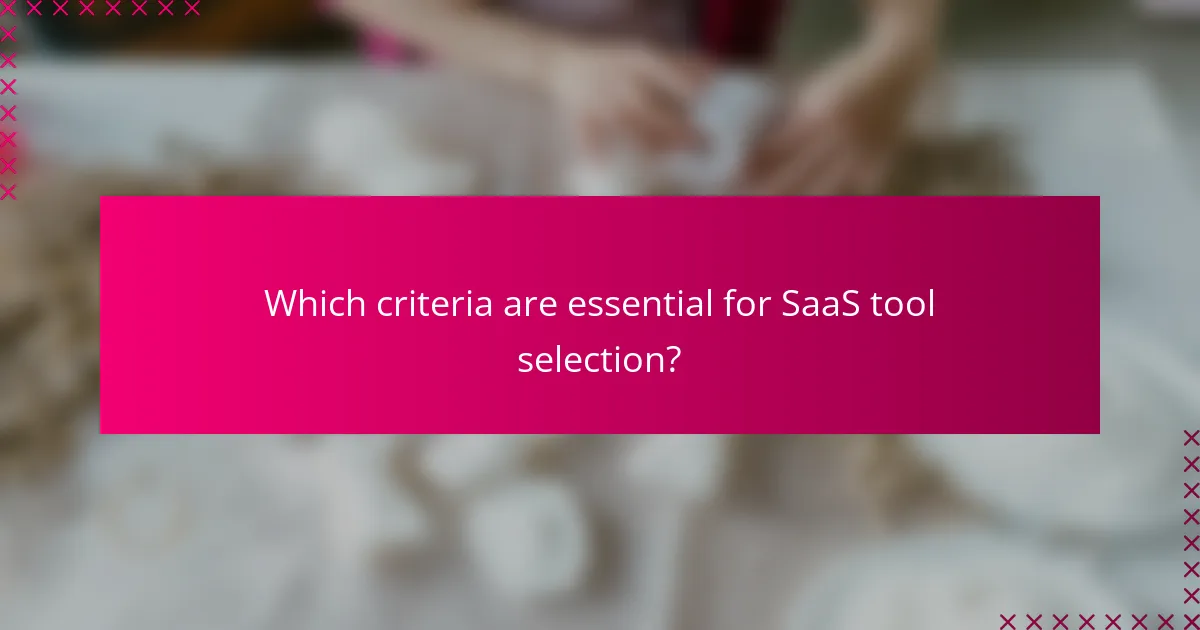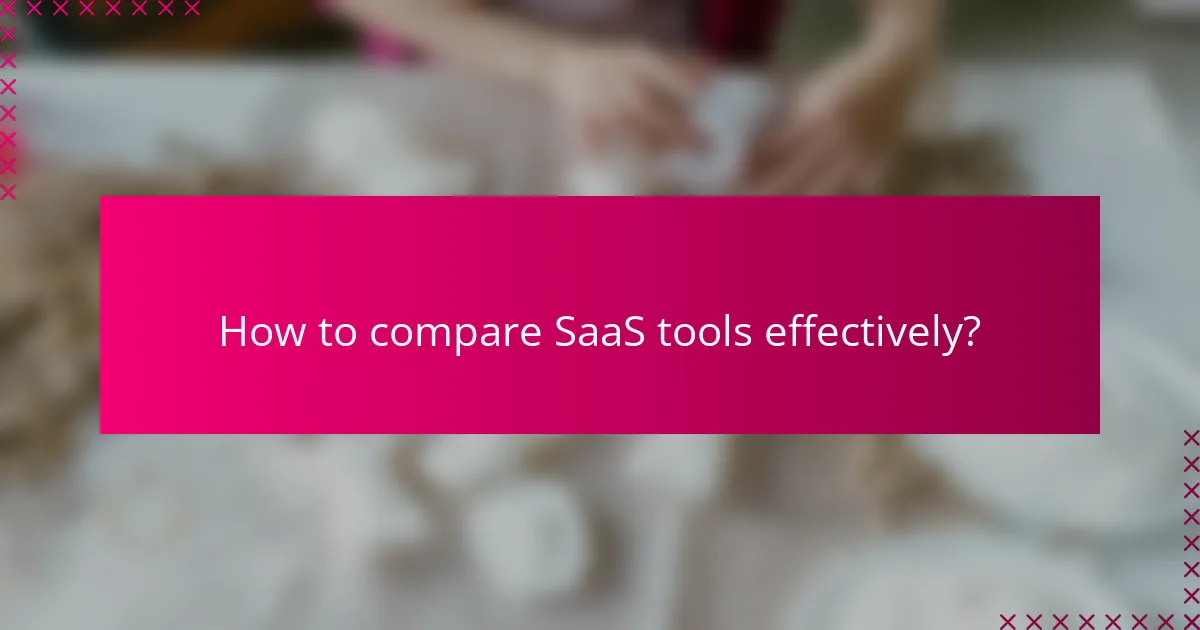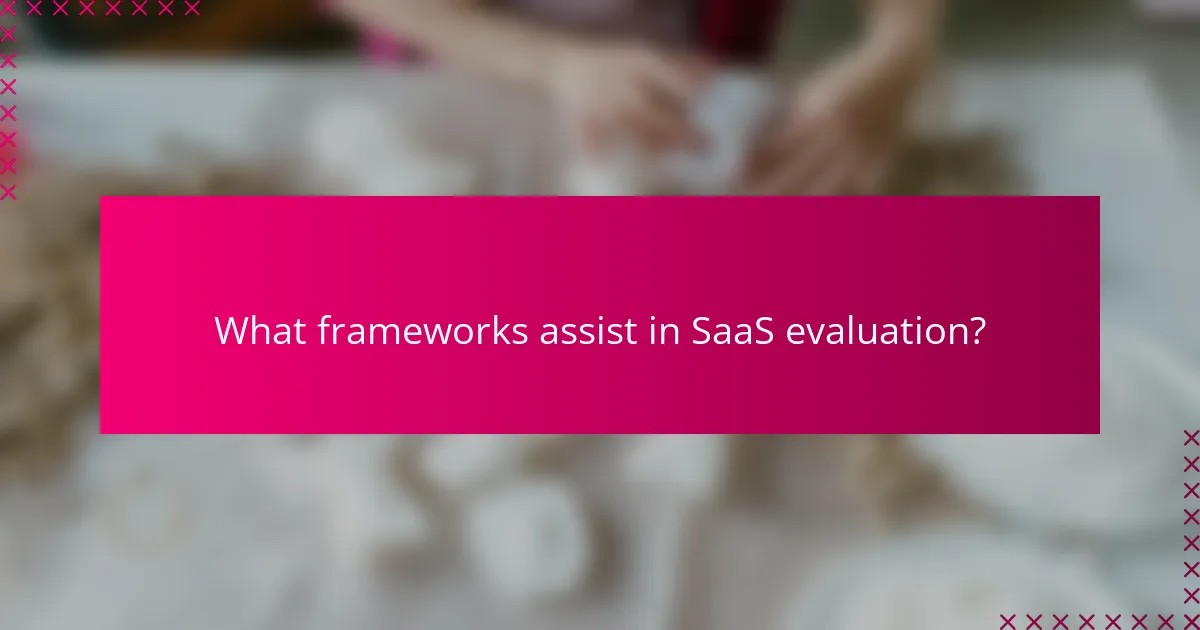Choosing the right SaaS tool for your business requires a thorough evaluation of performance benchmarks and essential criteria. Key metrics such as response time, uptime percentage, and scalability are crucial for assessing reliability and efficiency. Additionally, factors like user experience, integration capabilities, and security standards play a vital role in ensuring the selected tool aligns with your operational needs.

How to evaluate SaaS tools in the UK?
Evaluating SaaS tools in the UK involves assessing various performance benchmarks and criteria that align with your business needs. Key factors include performance metrics, user experience, integration capabilities, and cost-effectiveness.
Performance metrics
Performance metrics are crucial for determining how well a SaaS tool meets your operational requirements. Key metrics to consider include uptime, response time, and load capacity, which should ideally be in the high nineties for uptime and low tens of milliseconds for response time.
When evaluating these metrics, look for tools that provide transparent reporting and adhere to industry standards. A good practice is to compare performance data from multiple vendors to identify the best fit for your needs.
User experience
User experience (UX) significantly impacts how effectively your team can utilize a SaaS tool. A well-designed interface should be intuitive, allowing users to navigate easily without extensive training.
Consider conducting user testing or gathering feedback from potential users before making a decision. Look for features such as customizable dashboards and mobile accessibility to enhance overall usability.
Integration capabilities
Integration capabilities determine how well a SaaS tool can work with your existing systems. It’s essential to choose tools that offer seamless integration with popular platforms like CRM, ERP, or project management software.
Check for available APIs and pre-built connectors, as these can significantly reduce implementation time. Tools that support standard integration protocols will generally provide a smoother experience.
Cost-effectiveness
Cost-effectiveness is a critical factor when selecting a SaaS tool, especially in the competitive UK market. Evaluate not only the subscription costs but also any additional fees for features, support, or integrations.
To ensure you’re getting value for your investment, consider the total cost of ownership over time. Look for tools that offer flexible pricing models, such as pay-as-you-go or tiered plans, to align with your budget and usage patterns.

What performance benchmarks should be considered?
When selecting a SaaS tool, key performance benchmarks include response time, uptime percentage, and scalability. These metrics help assess the reliability and efficiency of the software, ensuring it meets your business needs.
Response time
Response time measures how quickly a SaaS application reacts to user inputs. Ideally, response times should be in the low tens of milliseconds for optimal user experience. A delay beyond 100 milliseconds can noticeably affect usability and productivity.
When evaluating response time, consider the application’s performance during peak usage. Testing under various load conditions can reveal how the tool handles increased demand, which is crucial for maintaining efficiency during busy periods.
Uptime percentage
Uptime percentage indicates the reliability of a SaaS tool, representing the amount of time the service is operational. A good benchmark is an uptime of 99.9% or higher, which translates to only a few hours of downtime annually.
To assess uptime, review the service level agreements (SLAs) provided by the vendor. These documents often outline the expected uptime and any compensation for failures, helping you understand the potential impact on your operations.
Scalability
Scalability refers to the ability of a SaaS application to handle growth, whether through increased user numbers or expanded functionality. A scalable solution should accommodate your business’s evolving needs without significant performance degradation.
When evaluating scalability, consider both vertical and horizontal scaling options. Vertical scaling involves upgrading existing resources, while horizontal scaling adds more instances. Choose a tool that offers flexibility in scaling to adapt to your future requirements efficiently.

Which criteria are essential for SaaS tool selection?
Essential criteria for SaaS tool selection include the feature set, customer support, and security standards. Evaluating these aspects helps ensure the chosen tool meets your business needs and maintains operational integrity.
Feature set
The feature set of a SaaS tool should align with your specific business requirements. Consider what functionalities are essential for your team, such as project management, collaboration, or data analytics. A tool offering a comprehensive feature set can enhance productivity and streamline workflows.
When assessing features, prioritize those that provide the most value. For instance, if your team relies heavily on real-time collaboration, look for tools that support live editing and integrated communication features. Create a checklist of must-have features to avoid overlooking critical capabilities.
Customer support
Customer support is crucial for resolving issues and ensuring smooth tool operation. Evaluate the support options available, such as live chat, email, or phone support, and consider the responsiveness and availability of these services. A tool with robust customer support can significantly reduce downtime and frustration.
Look for providers that offer extensive resources, including documentation, tutorials, and community forums. This can empower your team to troubleshoot minor issues independently. Additionally, consider the support hours and whether they align with your operational schedule, especially if you operate across different time zones.
Security standards
Security standards are vital for protecting sensitive data and maintaining compliance with regulations. Ensure the SaaS tool adheres to industry-standard security protocols, such as encryption, access controls, and regular security audits. This is particularly important for businesses handling personal or financial information.
Familiarize yourself with relevant regulations, such as GDPR or HIPAA, depending on your industry. Verify that the SaaS provider offers compliance certifications and has a clear data protection policy. Regularly review their security practices to stay informed about any updates or changes that may affect your data security.

How to compare SaaS tools effectively?
To compare SaaS tools effectively, focus on key performance metrics and user experience. Evaluating features, pricing, and customer feedback will help you make informed decisions tailored to your specific needs.
Side-by-side comparisons
Side-by-side comparisons allow you to evaluate multiple SaaS tools based on essential criteria such as pricing, features, and performance. Create a comparison chart that includes key functionalities, support options, and integration capabilities to visualize differences clearly.
Consider using a scoring system to rate each tool on a scale, which can help highlight strengths and weaknesses. This method provides a quick reference to identify the best fit for your requirements.
Customer reviews
Customer reviews are invaluable for gauging the real-world performance of SaaS tools. Look for reviews on reputable platforms where users share their experiences, focusing on aspects like usability, customer support, and reliability.
Pay attention to both positive and negative feedback, as this can reveal common issues or standout features. Aim for tools with a significant number of reviews to ensure a balanced perspective.
Trial periods
Trial periods offer a hands-on opportunity to assess SaaS tools before committing financially. Most providers offer free trials ranging from a week to a month, allowing you to explore features and usability in your specific context.
During the trial, test critical functionalities and gather feedback from your team to ensure the tool meets your operational needs. Be cautious of automatic renewals; always check the terms to avoid unexpected charges after the trial ends.

What are the common pitfalls in SaaS selection?
Common pitfalls in SaaS selection include failing to account for hidden costs and neglecting user feedback. These oversights can lead to unexpected expenses and a lack of user satisfaction, ultimately affecting the overall success of the software implementation.
Overlooking hidden costs
Many organizations focus solely on the subscription price when selecting a SaaS tool, ignoring additional expenses that can accumulate. Hidden costs may include implementation fees, training expenses, and ongoing maintenance charges. It’s crucial to evaluate the total cost of ownership over the software’s lifecycle.
To avoid surprises, create a checklist of potential hidden costs. Consider factors such as data migration, integrations with existing systems, and any necessary upgrades. A thorough cost analysis can help ensure that the selected solution fits within your budget.
Ignoring user feedback
User feedback is vital in the SaaS selection process, yet it is often overlooked. Engaging end-users early can provide insights into their needs and preferences, which can significantly influence the effectiveness of the chosen tool. Ignoring this input may lead to poor adoption rates and dissatisfaction.
To incorporate user feedback, conduct surveys or focus groups to gather opinions on potential SaaS options. Additionally, consider pilot testing a few solutions with a small group of users to assess functionality and usability before making a final decision. This approach can help ensure that the selected software meets the actual needs of your team.

What frameworks assist in SaaS evaluation?
Several frameworks can help organizations evaluate Software as a Service (SaaS) solutions effectively. These frameworks provide structured approaches to assess performance, features, and overall fit for business needs.
Decision matrices
Decision matrices are tools that help compare multiple SaaS options based on specific criteria. They allow teams to evaluate features, costs, and performance metrics side by side, facilitating a clearer decision-making process.
To create a decision matrix, list your criteria on one axis and the SaaS options on the other. Assign scores based on how well each option meets the criteria, then calculate the total scores to identify the best fit. Common criteria include pricing, user experience, integration capabilities, and customer support.
When using decision matrices, ensure that the criteria are prioritized according to your organization’s needs. Avoid overloading the matrix with too many options or criteria, as this can lead to analysis paralysis. A focused approach with 5-7 key criteria often yields the best results.
